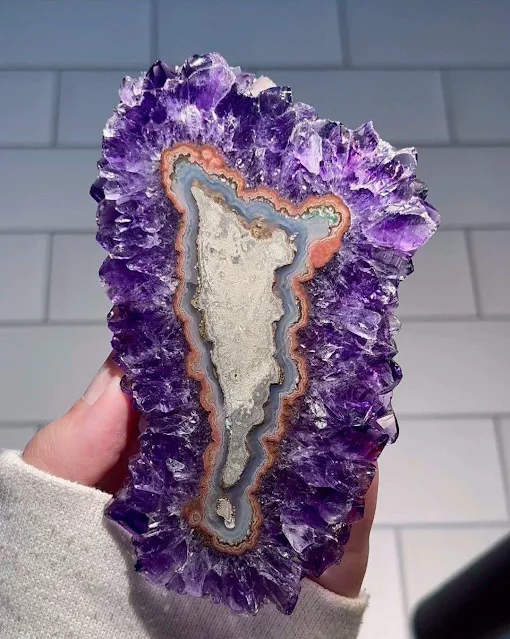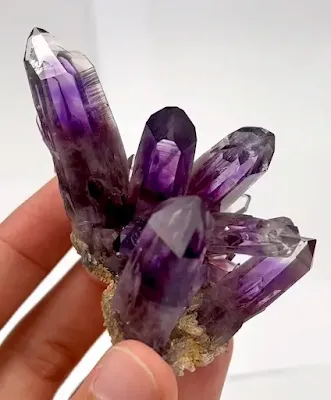Amethyst: Color, Formation, Properties, Uses
Amethyst is a beautiful purple variety of quartz. Its color ranges from light lavender to deep violet, and it can be transparent to translucent. Amethyst comes in various shades of purple, ranging from light lilac to deep violet. The most valuable and sought-after color is a rich, deep purple with red and blue flashes.
Amethyst is the birthstone for February and is associated with qualities like stability, peace, and inner strength.
The name "amethyst" comes from the Greek word "amethystos," which means "not drunken." This is because the ancient Greeks believed that amethyst could protect its wearer from intoxication. Amethyst was also believed to have other magical properties, such as the ability to ward off evil spirits and promote good dreams.
Amethyst is found in many parts of the world, including Brazil, Uruguay, South Africa, and the United States.
 |
| Amethyst Snowflake Cut. |
How is Amethyst Formed
Amethyst forms through the slow crystallization of silica-rich hydrothermal fluids within cavities of volcanic rocks, with trace impurities of iron and other elements contributing to its purple color.
Here's a step-by-step explanation of how amethyst is formed:
Magmatic Activity
The formation of amethyst begins with magmatic activity, where silica-rich magma beneath the Earth's surface gives rise to hot fluids; these fluids, associated with volcanic or hydrothermal activity, circulate through the crust at high temperatures, allowing amethyst to crystallize from the silica content when conditions like temperature and chemical composition are suitable.
Quartz Crystallization
As the hydrothermal fluid cools, dissolved silica (SiO₂) precipitates and forms quartz, the mineral to which amethyst belongs. This typically occurs within cavities within volcanic rocks, geodes, or fractures in existing rock formations.
Iron Incorporation
During the crystallization process, iron and aluminum impurities are introduced into the quartz crystal lattice. Trace elements of iron (Fe³⁺) and other transition metals present in the fluid become incorporated into the growing quartz lattice. These impurities act as chromophores, selectively absorbing specific wavelengths of light and generating the characteristic purple color of amethyst.
Radiation Activation
As the quartz crystals continue to grow, they are exposed to radiation from the surrounding rocks. This radiation damage causes the iron impurities to become trapped within the crystal lattice. This radiation enhances the purple color of amethyst through electronic transitions within the chromophore, leading to deeper and more vibrant hues.
Geochemical Conditions
The specific shade and intensity of amethyst color is influenced by several factors, including the type and concentration of iron impurities, the duration and intensity of radiation exposure, and the presence of other trace elements within the crystal lattice.
Crystal Growth and Zoning
The formation of amethyst can occur over millions of years, with crystals growing slowly and gradually. This can lead to color banding or zoning within the crystal, reflecting variations in the concentration of iron impurities and the timing of radiation exposure throughout the growth process.
Geode Formation: In some cases, amethyst crystals form within geodes, which are hollow cavities within volcanic rocks lined with mineral crystals. These geodes can contain stunning specimens of amethyst with well-developed crystal faces and intricate color patterns.
 |
| Amethyst stalactite slice |
Properties of Amethyst
Amethyst is a transparent, violet-colored gemstone. The color of amethyst is caused by the presence of iron impurities. The deeper the purple color, the more valuable the amethyst is considered to be. Amethyst can also exhibit asterism, which is a phenomenon that causes a star-like pattern to appear within the stone.
Composition: Amethyst is a variety of microcrystalline quartz (SiO₂) with trace amounts of iron oxide (Fe₂O₃) responsible for its color.
Amethyst Physical Properties
- Color: Amethyst color typically ranges from pale lilac to deep violet, but can also appear in reddish-purple or even greenish-purple hues. The intensity of the color varies depending on the iron content and distribution within the crystal lattice.
- Luster: Amethyst exhibits a vitreous (glassy) luster, reflecting light brilliantly and creating a mesmerizing sparkle.
- Crystal System: Amethyst belongs to the trigonal crystal system, meaning its crystals exhibit three-fold rotational symmetry.
- Streak: When scratched, Amethyst leaves a white streak, similar to pure quartz.
- Hardness: Amethyst boasts a hardness of 7 on the Mohs scale, making it relatively durable and resistant to scratching. This makes it suitable for jewelry and other decorative applications.
- Cleavage: Amethyst lacks distinct cleavage, meaning it does not break along specific planes or directions. However, it can exhibit conchoidal fracture, meaning it breaks into irregular, curved pieces.
- Crystal Form: Amethyst commonly forms in druzy clusters, geodes, and individual crystals with varying shapes and sizes. These shapes can include hexagonal prisms, pyramids, and scepters.
- Density: The density of Amethyst is around 2.65 g/cm³, slightly higher than pure quartz due to the presence of iron.
- Transparency: Amethyst can be transparent to translucent, depending on the quality and presence of inclusions. Gem-quality Amethyst is generally transparent or semi-translucent, allowing light to pass through and showcase its color and depth.
- Specific Gravity: The specific gravity of Amethyst is around 2.65, which is the ratio of its density to the density of water. This means Amethyst is slightly denser than water.
- Fracture: Conchoidal (curved, shell-like)
- Solubility: Amethyst is insoluble in water and most common acids, making it resistant to weathering and corrosion.
- Magnetism: Amethyst is not magnetic and is not attracted to magnets.
Amethyst Optical Properties
- Fluorescence: Some Amethyst varieties exhibit weak to moderate fluorescence under longwave ultraviolet light, with colors ranging from red to orange.
- Pleochroism: Amethyst exhibits weak pleochroism, meaning its color can appear slightly different depending on the viewing angle. This is due to the uneven distribution of iron within the crystal lattice.
- Refractive Index: The refractive index of Amethyst is around 1.54 to 1.55, slightly higher than pure quartz. This indicates how much light bends when passing through the crystal.
Additional Properties
- Inclusions: Amethyst can contain various inclusions, such as rutile needles, goethite, and chalcedony. These inclusions can sometimes add unique patterns and textures to the gemstone, enhancing its beauty.
- Heat Sensitivity: Amethysts can fade and lose their color if heated too much.
 |
| Amethyst crystals cluster |
Amethyst Color
Amethyst color forms when trace impurities of iron (Fe³⁺) and other transition metals replace silicon atoms in the crystal structure of quartz. Natural irradiation further enhances the color. Depending on the type and amount of radiation, the resulting amethyst can display a variety of purple hues.
Amethyst exhibits a range of purple hues due to variations in the concentration of iron (Fe) impurities and the degree of natural radiation exposure the crystal has undergone. Higher Fe content and more intense radiation generally result in deeper, richer purples.
The purple coloration originates from the presence of Fe⁴⁺ ions within the quartz crystal lattice. Natural background radiation excites electrons in these Fe³⁺ ions, causing them to lose an electron and transition to the Fe⁴⁺ state. This creates a vacancy in the crystal structure, known as a color center.
The color center selectively absorbs specific wavelengths of visible light. The remaining unabsorbed wavelengths are then perceived by the human eye, resulting in the characteristic purple hue of amethyst.
Heat exposure can disrupt the Fe⁴⁺ state, leading to the loss of the purple color and a transformation into yellow or brown tones.
Amethyst Uses
Amethyst holds a place not only in the world of jewelry but also in various other fields, with its diverse uses spanning across the practical, scientific, and even spiritual realms. Here's a breakdown of its notable applications:
Jewelry and Ornamentation
- Gemstone: One of the most common uses of amethyst is in jewelry. Its stunning purple color makes it a popular choice for rings, necklaces, earrings, bracelets, and pendants. It can be cut and polished into various shapes and styles, from faceted gems to cabochons.
- Decorative Objects: Amethyst's beauty extends beyond personal adornment. It graces decorative objects like sculptures, figurines, lamp bases, and ornamental bowls, adding a touch of elegance and sophistication to any space.
Scientific and Technological Applications
- Piezoelectric Properties: Amethyst exhibits piezoelectric properties, meaning it generates an electric current when pressure is applied. This property finds use in various scientific instruments and sensors, such as pressure gauges and accelerometers.
- Optical Applications: Some amethysts have potential in optical applications due to their ability to transmit certain wavelengths of light. This characteristic could be utilized in lasers, filters, and other optical devices.
Metaphysical and Healing Practices
- Traditional Beliefs: Many cultures associate amethyst with healing properties, believing it can alleviate stress, anxiety, and insomnia. It's also linked to spiritual well-being and is said to promote inner peace, balance, and intuition.
- Crystal Healing: Crystal healers use amethyst in various practices, believing it can cleanse negative energy, balance chakras, and promote emotional and physical well-being. While these beliefs lack scientific evidence, they represent a significant cultural role amethyst plays.
 |
| Amethyst color by origin. Photo by: Labradorite King |
Historical and Cultural Significance:
- Ancient Civilizations: Amethyst has been revered for centuries. Ancient Egyptians used it in jewelry and ceremonial objects, Romans believed it protected against drunkenness, and the Greeks associated it with Bacchus, the god of wine.
- Birthstone and Symbolic Meaning: Amethyst serves as the birthstone for February and is often associated with themes of royalty, sobriety, and spiritual protection. Its unique color and historical significance imbue it with symbolic meaning across various cultures.
Investment and Collectibles:
- Valuable Gemstone: High-quality amethysts with vibrant color and excellent clarity can be valuable investments and collector's items.
- Unique Specimens: Geodes containing amethyst crystals and rare forms like ametrine (a combination of amethyst and citrine) are sought after by gem collectors due to their beauty and unique geological formations.
 |
| Amethyst crystals from Vera Cruz, Las Vigas, Mexico photo: László Kupi |
Amethyst Meaning and Symbolism
Amethyst has a long history of being associated with spirituality, peace, and protection. In ancient Greece, amethyst was believed to protect its wearer from intoxication. The stone was also thought to promote good dreams and ward off evil spirits.
Today, amethyst is still associated with these same qualities. It is often used in jewelry to promote peace, tranquility, and protection. Amethyst is also a popular stone for meditation and healing.
How to Care for Amethyst
Amethyst is a relatively durable gemstone, but it is important to care for it properly. Amethyst should be stored in a cool, dry place. It should also be protected from scratches and other damage.
If you wear amethyst jewelry, you should avoid wearing it in water or in contact with harsh chemicals. You should also avoid wearing it while doing activities that could scratch or damage the stone.
 |
| Amethyst cluster on matrix from Amatitlan, Mexico Photo: Min_minerals |
Where to Buy Amethyst
Amethyst can be found in many jewelry stores and online retailers. You can also find amethyst geodes and other raw amethyst specimens at mineral shows and rock shops.
Facts About Amethyst
- Amethyst is a variety of quartz, which is the second most abundant mineral in the Earth's crust.
- Amethyst's purple color is caused by iron impurities.
- The deepest purple amethysts are the most valuable.
- Amethyst can be heat-treated to change its color from purple to yellow.
 |
| Huge amethyst geode from Uruguay Photo: Le Stage Minerals |
Conclusion
Amethyst is a beautiful and versatile gemstone that has been prized for centuries for its beauty, its metaphysical properties, and its durability. If you are looking for a gemstone that is both stylish and meaningful, amethyst is a great choice.
Read also
Amethyst Stalactites: A Rare and Mysterious Formation
The Giant Amethyst Geodes in Uruguay
Ametrine: A Blend of Amethyst and Citrine
Purple Gemstones and Crystals


%20(1).webp)






